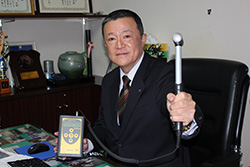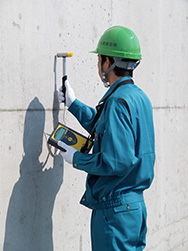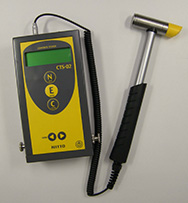Meet Japanese Companies with Quality
Hammering the data home Nitto Construction Inc.
Website: Nitto Construction Inc.![]()
Category: Japanese Machinery
Accidental inspiration
Hajime Kubo at Oumu, Hokkaido-based Nitto Construction had a dilemma: construction projects were diminishing but he didn't want to cut workers, as other jobs in his small town were scarce. Inspiration hit in 1999, when a falling piece of concrete struck a bullet train passing through a tunnel. While no passengers were hurt, Kubo suspected that much of Japan's old concrete was nearing the end of its lifespan. However, rebuilding was not a viable option financially-repairing old or damaged concrete was more cost-effective.

Nitto Construction President and CEO Hajime Kubo

Obtaining accurate data is a significant advantage for the Kubo hammer over standard testing methods
Non-destructive concrete testing
There are two simple existing non-destructive ways to test concrete for repair. In one, an instrument causes a spring-loaded mass to strike the concrete, and the force of the rebound is measured. Positioning the device for accurate data is tricky; it can damage the concrete surface and data interpretation varies. The other solution is to have a specialist tap the concrete with a hammer and listen for discrepancies that indicate faulty areas. Yet Kubo points out there is always a degree of subjectivity without supporting data. "If person A says it is okay, and person B says it isn't, who do you trust?" Moreover, he noted that this method is difficult in noisy tunnels, and specialists are gradually dwindling in number.
A smart hammer
Kubo spoke with his former civil engineering professor, who had been pondering more modern concrete testing methods. His professor had an idea that Kubo offered to help commercialize, and subsequent research and development produced their first concrete tester in 2005. The CTS-02 looks much like an ordinary hammer, but it contains an acceleration sensor that measures the waveform of impact force when struck on a concrete surface. The device directly records the data and measures the strength of the concrete. Most importantly, it's quite accurate and simple to operate.

The CTS-02 hammer's yellow tip indicates the location of an acceleration sensor

The CEO has been attending trade shows abroad to promote his device
Attention from abroad
Kubo knows that getting his tester to be recognized in the industry is a hurdle, yet word of the device is spreading. His new line of work is just in its infancy. Another incident involving aging infrastructure, the deadly Sasago Tunnel collapse on an expressway in December 2012, prompted him to further develop his technology. Aging bolts that had loosened were found to be the main cause, and Kubo is developing a new version of his hammer to test the integrity of metal nuts and bolts for safety inspections. "We plan to have it ready around May of 2014," he declared.
Website: Nitto Construction Inc.![]()



